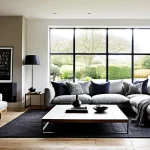Integrating Modern Design Elements for Enhanced Home Comfort
Creating modern living spaces that prioritise both form and function is key to achieving ultimate comfort and usability. One popular approach is using open floor plans, which remove barriers between common areas. This design not only fosters a sense of inclusivity but also offers flexible use for family gatherings, work-from-home setups, or relaxed leisure.
Maximising natural light plays a pivotal role in enhancing home comfort. Incorporating large windows and skylights invites abundant sunlight, making rooms feel more spacious and uplifting mood naturally. This strategy reduces reliance on artificial lighting while visually connecting indoor spaces to the outdoors.
Have you seen this : What Are the Key Trends Shaping UK Home Interiors Today?
Blending indoor and outdoor spaces is another hallmark of modern home design. Seamlessly integrating patios, decks, or gardens with living rooms extends usable space, encourages outdoor living, and introduces fresh air. Thoughtfully designed transitions, such as sliding glass doors or covered terraces, ensure usability throughout the year.
By focusing on these elements—open layouts, natural light, and indoor-outdoor flow—homes become not only aesthetically pleasing but also highly comfortable and usable, perfectly suited for contemporary lifestyles.
Additional reading : How Can Smart Technology Transform Your Home Style?
Leveraging Smart Technology for Daily Convenience
Integrating smart home technology greatly enhances convenience and everyday comfort in modern homes. Centralised control hubs allow users to manage lighting, climate, and security systems effortlessly from a single interface. This automation not only saves time but also improves usability by simplifying complex tasks.
Automated lighting adjusts brightness based on time of day or occupancy, creating optimal ambiance while conserving energy. Similarly, smart thermostats maintain precise temperature control, ensuring consistent thermal comfort tailored to individual preferences. Security systems offer real-time monitoring and alert features, reinforcing safety without constant manual checks.
Beyond convenience, these technologies provide adaptability through voice commands or smartphone apps, accommodating diverse lifestyles in modern living spaces. For example, schedule-driven routines can prepare your home for arrival or bedtime, maintaining comfort with minimal intervention.
Experts highlight that seamless smart integrations promote peace of mind and efficient resource use, making homes not only smarter but also more responsive to residents’ needs. Embracing smart tech transforms homes into intuitive environments that support comfort, usability, and convenience, elevating the standard of modern home design for daily living.
Prioritising Energy Efficiency and Sustainable Materials
Energy efficiency lies at the core of sustainable home design, directly impacting thermal comfort year-round. Advanced insulation materials limit heat loss in winter and prevent heat gain in summer, maintaining a stable indoor temperature while reducing reliance on heating and cooling systems. Complementing insulation, energy-efficient windows with multiple glazing layers and low-emissivity coatings further enhance comfort by minimising drafts and UV exposure.
Sustainable home design also embraces eco-friendly materials, such as responsibly sourced wood, recycled composites, and non-toxic finishes. These choices promote a healthier living environment by reducing indoor pollutants and lowering the home’s overall environmental footprint. For example, using low-VOC paints significantly improves air quality, contributing to both comfort and wellness.
The benefits extend beyond health and comfort; energy-efficient and sustainable materials contribute to lower utility costs through reduced energy consumption. Over time, this translates to significant savings and reinforces the practicality of integrating eco-conscious elements into modern living spaces. Choosing materials carefully aligns with growing homeowner priorities, ensuring modern home design achieves both environmental responsibility and lasting comfort.
Focusing on Ergonomics and Adaptive Spaces
Creating ergonomic furniture is essential to enhancing home wellness by improving posture and reducing physical strain during daily activities. Ergonomic chairs and desks designed with adjustable heights and lumbar support ensure comfort, especially for those working or studying at home. This focus directly contributes to usability by supporting health and productivity.
Adaptive spaces in modern living spaces offer flexibility, allowing rooms to transform based on changing needs—whether for work, leisure, or exercise. For example, foldable desks and modular seating can quickly alter a room’s function without sacrificing style or comfort. This adaptability maximises the use of limited space while maintaining a seamless flow throughout the home.
Customisable storage solutions also play an important role in functional design. Built-in shelves, under-bed drawers, and multi-purpose furniture reduce clutter effectively, making rooms feel more spacious and organised. As a result, these ergonomic and adaptable elements together enhance both comfort and usability in modern home design, ensuring spaces support evolving lifestyles with ease and efficiency.






